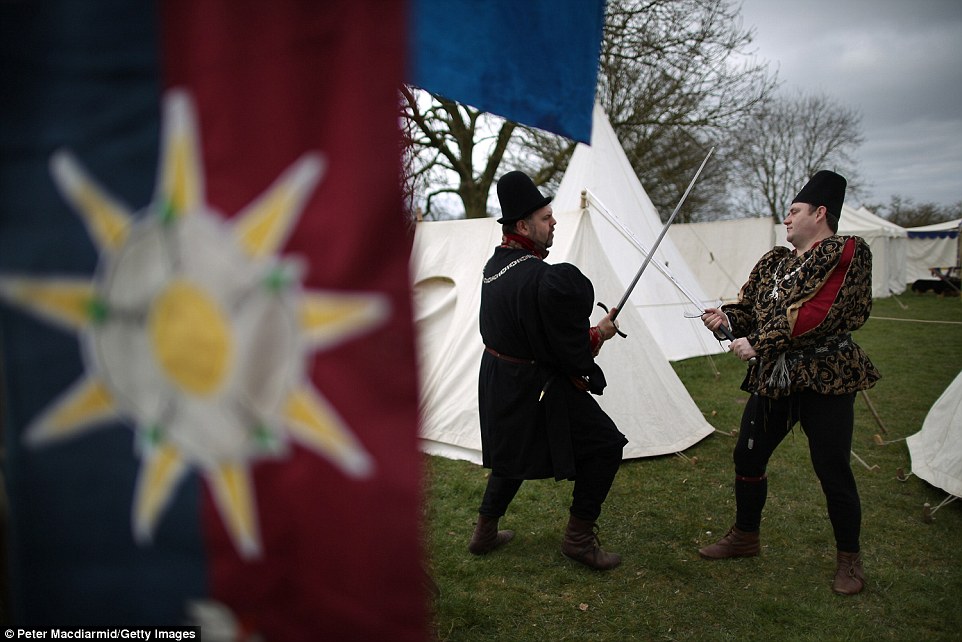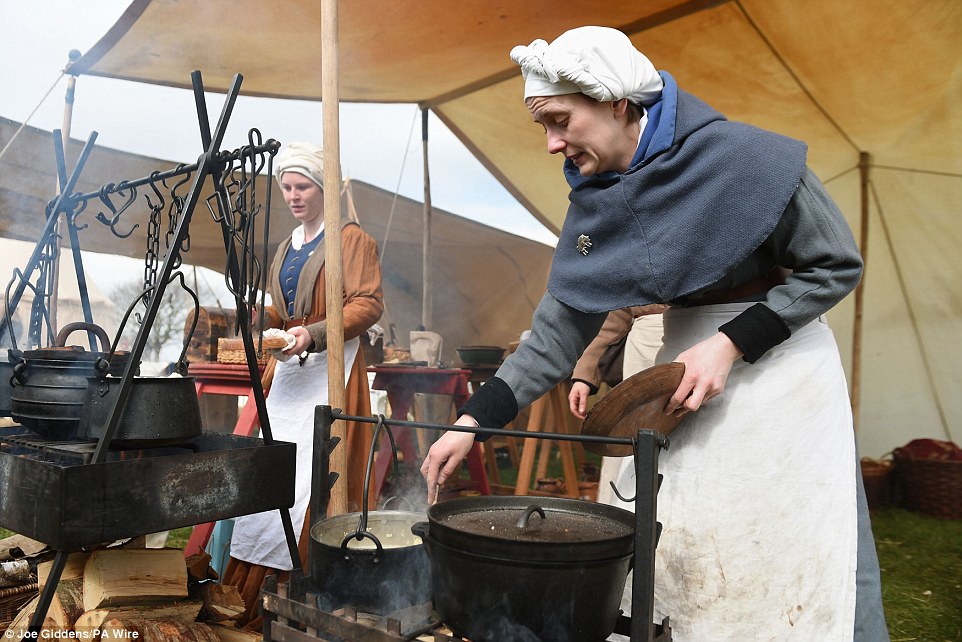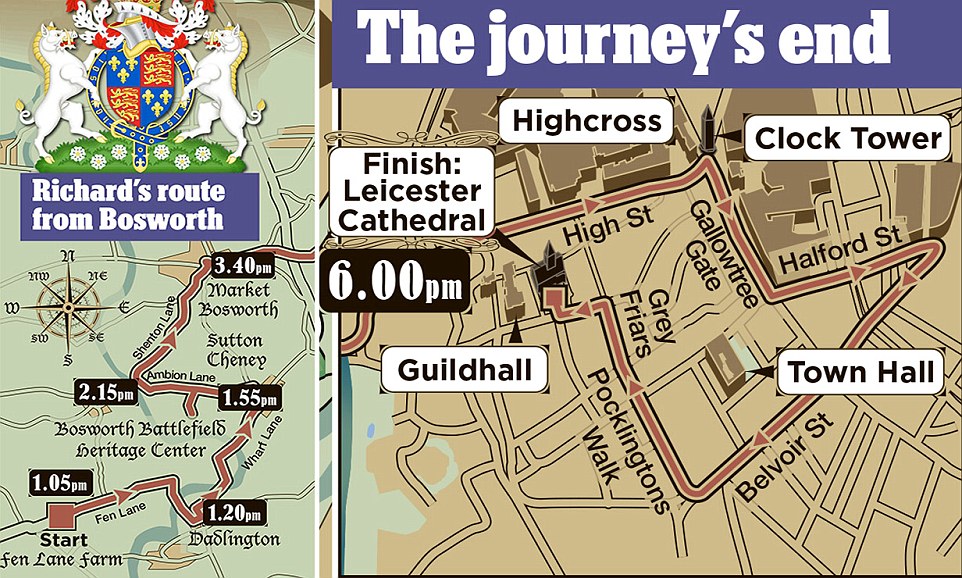Today marks one week exactly until King Richard III is to be reburied with great pomp and ceremony in Leicester Cathedral.
To prepare for the ceremony, which will see the cortege travel through Leicestershire, his remains have been sealed inside a lead-lined coffin - 530 years after he died.
Canadian Michael Ibsen, the closest living relative of the dead English king, has been responsible for hand carving the coffin from English oak and yew.
The 5ft 10inch long coffin has been lined with 132lbs of lead to help protect the body of the last Plantagenet King.
On Sunday, the coffin, which weighs a total of 242lbs, will leave Leicester University to a waiting hearse - giving the public the first glimpse of the coffin.
From here it will then be carried to Fenn Lane Farm close to where the battle of Bosworth took place and reputedly the site of King Richard's death.
The procession will then continue Dadlington and Sutton Cheney, where King Richard is thought to have taken his final Mass at St James' church on the eve of the battle where he met his end.
The Bishop of Leicester, the Rt Revd Tim Stevens, will then lead a short ceremony at the Bosworth Battlefield Heritage Centre at 2.20pm.
The cortege will then travel to Market Bosworth, Newbold Verdon and Desford as it makes its way back to Leicester.
The coffin will then be transferred onto a horse drawn gun carriage and a walking procession will accompany the king's remains to Leicester Cathedral.
Here King Richard's body will be received in a service known as compline and the Roman Catholic Archbishop of Westminster will preach at the sermon.
After resting in the cathedral for four days, Richard III's remains will be finally re-interred on Thursday 26 March.
The Archbishop of Canterbury Justin Welby will preside as the coffin is then lowered into a specially made tomb emblazoned with King Richard's boar sign inside the cathedral.
Channel 4, which is having a week-long series of live broadcasts of the re-interment, will broadcast the ceremony live.
Richard III sealed inside a lead-lined coffin made by his closest living relative ahead of his burial next week
Coffin of Richard III has been handmade by his 17th great grand nephew
Oak and yew coffin is lined with lead to protect the king's delicate skeleton
It was sealed ahead of the king's final procession and burial in Leicester
His body will be carried from Bosworth to Leicester Cathedral on Sunday
Service of compline to be held when king's remains arrive at the cathedral
Coffin will be lowered into stone tomb in cathedral the following Thursday
By Richard Gray for MailOnline
16 March 2015
Daily Mail
The remains of Richard III have been sealed inside a lead-lined coffin ahead of his reburial next week - 530 years after he died.
Michael Ibsen, the closest living relative of the dead English king, has been responsible for hand carving the coffin from English oak and yew.
The 5ft 10inch long coffin has been lined with 132lbs of lead to help protect the body of the last Plantagenet King.
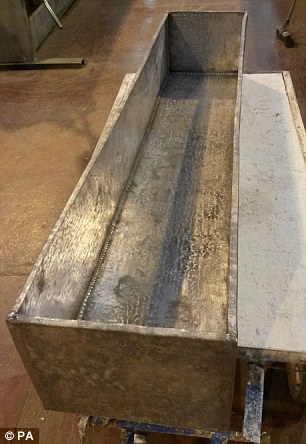
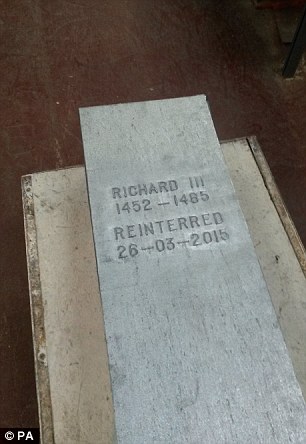
Richard III's remains are to be wrapped in wool and placed inside this lead ossuary (left) before it is sealed with the lid (right) bearing an inscription with the king's name, the dates of his life and the date of his reburial
Richard III's remains are to be wrapped in wool and placed inside this lead ossuary.
His body was packed in woolen fleece and linen inside the coffin at the University of Leicester's Council Room, formerly a Chapel.
It was placed inside the lead ossuary as if they were articulated and a rosary was placed inside the coffin together with an embroidered piece of Irish linen.
Small bones and scientific samples were wrapped up in small linen bags and placed inside.
The occasion was attended by representatives from the university, Leicester City Council, Leicster Cathedral, the Richard III Society, an independent witness and relatives of Richard III.
Once the lead inner casket was sealed, Mr Ibsen, a descendant of Richard III’s elder sister, Anne of York, fixed the lid of the outer coffin in position.
Mr Ibsen, a Canadian born cabinet maker who is the 17th great grand-nephew of Richard III, said he had tried to make the coffin using the same tools and techniques that had been used 500 years ago when the king had been alive.
Mr Ibsen's mitochondrial DNA, which is passed down through the female line in families, helped to confirm that the battled scarred skeleton found under a council car park in 2012 did belong to Richard III.
He said: 'There have been moments when I have been making the coffin over a period of a couple of weeks where I stand back at the end of the day and think: "this is for Richard III".
'It is really quite astonishing. It does give me pause for thought.'
Now his remains are inside the coffin, Richard III's remains will be carried on a procession on Sunday from the site where he died near Bosworth in Leicestershire to Leicester the Cathedral.
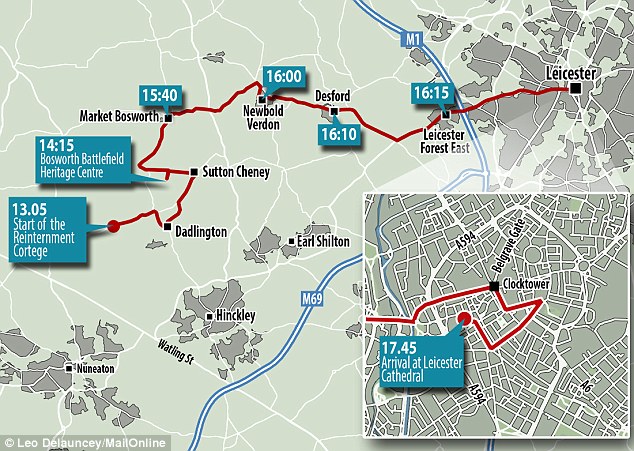
Richard III's coffin will be taken on a procession (above) across Leicestershire on Sunday ahead of his reburial
The coffin, which weighs a total of 242lbs, will leave Leicester University to a waiting hearse - giving the public the first glimpse of the coffin.
From here it will then be carried to Fenn Lane Farm close to where the battle of Bosworth took place and reputedly the site of King Richard's death.
The procession will then continue Dadlington and Sutton Cheney, where King Richard is thought to have taken his final Mass at St James' church on the eve of the battle where he met his end.
The Bishop of Leicester, the Rt Revd Tim Stevens, will then lead a short ceremony at the Bosworth Battlefield Heritage Centre at 2.20pm.
The cortege will then travel to Market Bosworth, Newbold Verdon and Desford as it makes its way back to Leicester.
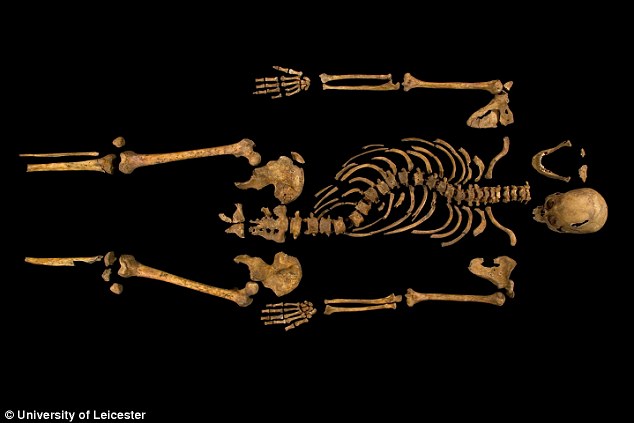
Richard III's skeleton found under a car park in Leicester was found to have 11 injuries sustained in battle
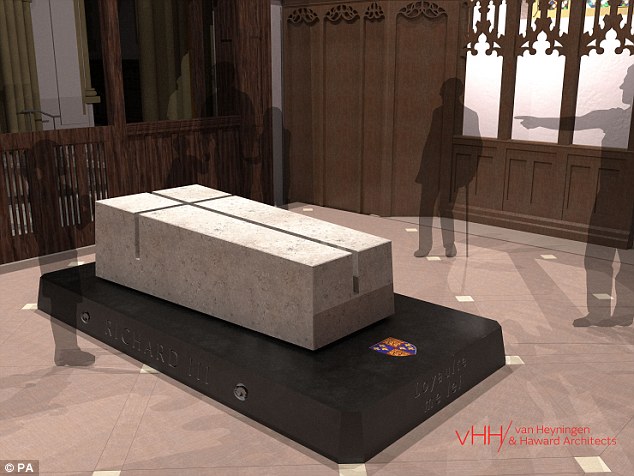
An artists impression of what the tomb containing Richard III will look like when he is reinterred next week
The coffin will then be transferred onto a horse drawn gun carriage and a walking procession will accompany the king's remains to Leicester Cathedral.
Here King Richard's body will be received in a service known as compline and the Roman Catholic Archbishop of Westminster will preach at the sermon.
After resting in the cathedral for four days, Richard III's remains will be finally re-interred on on Thursday 26 March.
The Archbishop of Canterbury Justin Welby will preside as coffin is then lowered into a specially made tomb emblazoned with King Richard's boar sigil inside the cathedral.
Bishop Stevens said it would be an emotional moment when the coffin was borne into the cathedral, not only for its symbolism but in remembrance of Richard the man.
He said: 'We're looking forward to the opportunity to remind people of the extraordinary moment in English history the death of Richard III marks.
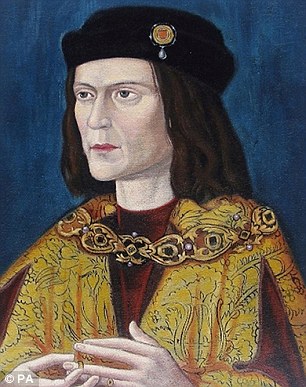
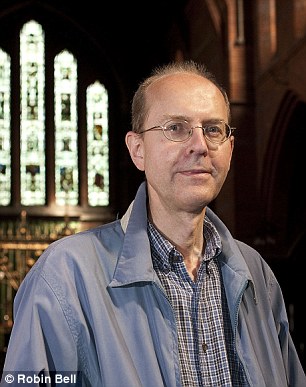
The coffin of Richard III (left) has been handmade from oak by his closest living relative Micheal Ibsen (right)
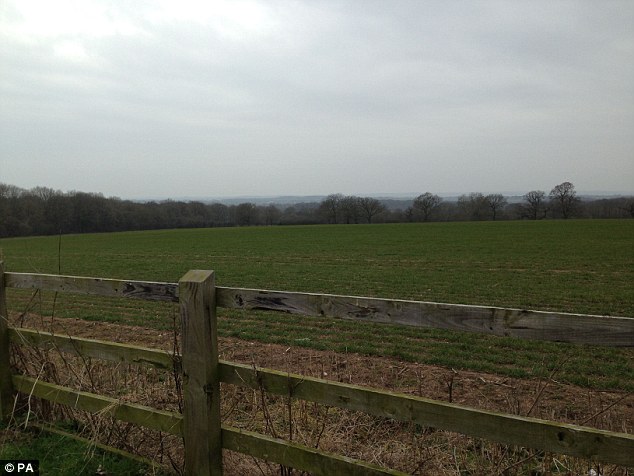
Richard III's remains will pass Bosworth Battlefied in Leicestershire (above), where the king suffered fatal wounds at the hands of forces loyal to Henry Tudor, during is procession to Leicester Cathedral on Sunday
'It was a change of dynasty, an end of a period of violent civil war, the beginning of the period in which Shakespeare was to write his great tragedies, including Richard III, and a different way of governing the country.
'That's an important point for all of us, whether we happen to be Christian observers or not.'
He added that the service of compline, which can trace its roots to the pre-Reformation church, would happen at dusk as it is a time when people's thoughts turn to night and the possiblity of dusk.
The service was chosen due to its links to Richard III's catholic faith.
More than 500 volunteers have been recruited to help during the reburial and a new piece of music has been specially written for the moment the coffin is carried to the spot where it will be buried.
The piece, Ghostly Grace written by composer Judith Bingham, has the same tempo as monks walking to convey a slow and solemn procession.
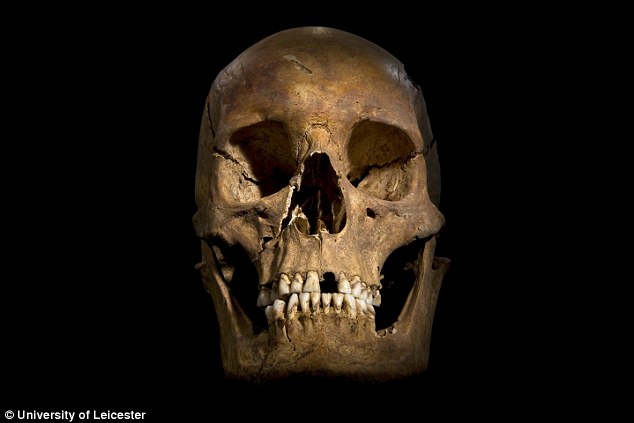
Scientists spent months studying the remains of Richard III (above), using genetic analysis to confirm that the battle-scarred skeleton discovered under a council car park in Leicester belonged to the last Plantagenet king
Florists have also chosen to decorate the cathedral with only British flowers in an attempt to mimic what would have been used in Medieval Britain.
Rosie Hughs, a royal florist from Leicestershire, said she had chosen willow, primroses, catkins and white lillies.
The windows of the cathedral will be dressed with white roses - the symbol of the Plantagenet House of York - donated by members of the public.
Mrs Hughs said: 'To be part of Richard's ceremony, and be a part of history, is wonderful.
'At last, the king will be laid to rest, with a proper burial, according to his own traditions.'
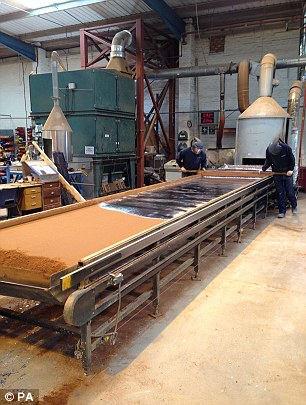
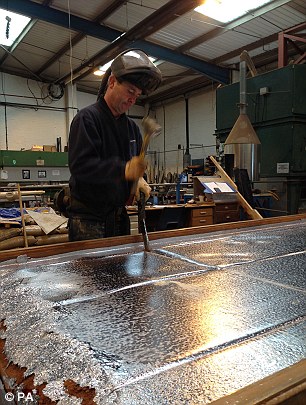
Molten lead was poured (left) by Norman & Underwood lead casters as they made the ossuary that will line his coffin before the sheets were cut (right) to create the box that will be finally welded shut later this week
The funeral procession and the reburial is to be broadcast live on Channel 4.
The reinterment itself will be attended by a number of dignitaries including Her Royal Highness the Countess of Wessex.
The reinterment of Richard III has been delayed by months after distant relatives brought a legal challenge through the courts arguing he should be reburied in York.
However, judges ruled in favour of Leicester, paving the way for a week of events marking the king's life and death, starting with the cortège on Sunday.
Dr Jon Castleman, chairman of Leicester lead-casters Norman and Underwood, will be responsible for sealing the lead ossurary.
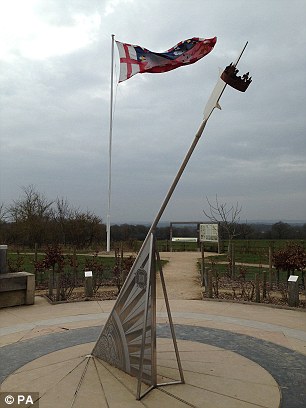

The coffin will pass Bosworth Battlefield where a memorial sundial (left) and 'throne' (right) have been erected on Ambion Hill to mark where Richard III was fatally wounded in battle by Tudor forces in 1485

The king's reburial on Thursday is to be broadcast live on Channel 4
With an assistant he will lift the lid onto the ossuary and weld the perimeter. He said it would be 'a very proud moment' for him.
The remains of Richard III were thought to have long been lost to history until archaeologists discovered his skeleton on the old site of Grey Friars monastery beneath a car park in the centre of Leicester.
Campaigner Philippa Langley battled for years for a dig on the site, despite rumours Richard's body had been dumped in the city river after his death.
Since his remains were excavated, scientists have been studying them in a bid to understand more about how he died.
They also used DNA extracted from his remains to help positively identify them as belonging to the king by matching them to known living relatives.
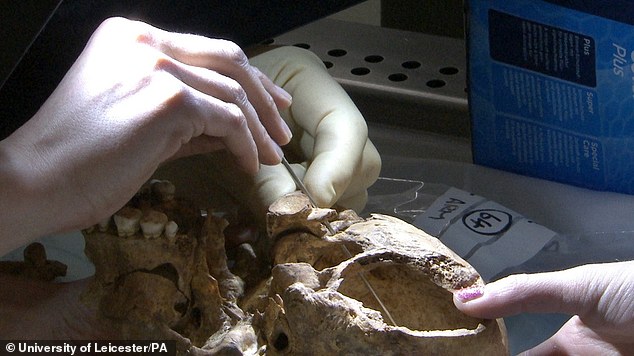
Scientists found injuries in the skull of Richard III lined up (above) to reveal the blow that killed him in battle
The scientists concluded that King Richard III had suffered eight head wounds including a fatal stab wound from the base of his skull that had penetrated right through his brain.
His death at the Battle of Bosworth at the hands of the forces fighting under the command of Henry Tudor ended the War of the Roses and Plantagenate rule in England.
The Dean of Leicester Cathedral, the Very Rev David Monteith, said while Sunday's service would be a solemn occasion it would not be a funeral.
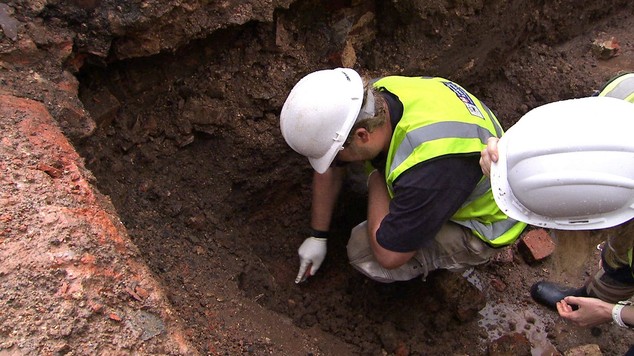
The picture above shows the moment Richard III's remains were first unearthed by archaeologists in Leicester
He said: 'There are no people immediately affected by this death in the way a close family member dying would have an impact upon you.
'That's not to say there isn't sadness about it and certainly for some a great sense of injustice.
'There's a sense of trying to put some things right from the past.
'But I'm aware you can't undo history, you have to live with history as it is and try to understand it.
'There's an opportunity for us to make history and I hope that becomes vivid and clear.'
THE BLOW THAT KILLED A KING
The blow that killed King Richard III in battle was so powerful that it went up through the base of his brain and left an indentation on the inside of his skull, scientists studying his remains have revealed.
Forensic pathologists at University of Leicester, discovered two wounds at the base of the king's skull along with a large indentation inside the cranium.
The findings suggest that a weapon such as a sword or a spike had been thrust upwards through the base of the king's neck so hard that it had gone straight through his brain to the other side of his skull.
Genetic analysis of the battle scarred skeleton, discovered under a council car park in Leicester three years ago, has confirmed that it did belong to Richard III.
Scientists studying the remains believe the king was surrounded by a mob of enemy soldiers and hacked to death after he had lost his helmet.
Using modern medical scanners, they established that the English monarch suffered 11 devastating injuries at the Battle of Bosworth Field in 1485.
RESEARCH SHOWS KING RICHARD MAY HAVE HAD MIDLANDS ACCENT
King Richard III would have sounded more like a Brummie than a northerner, according to a language expert.
Dr Philip Shaw, from the University of Leicester's School of English, used two letters penned by the last king of the Plantagenet line more than 500 years ago to try to piece together what the monarch would have sounded like.
He studied the king's use of grammar and spelling in postscripts on the letters.
Despite being the patriarch of the House of York, the king's accent 'could probably associate more or less with the West Midlands' than from Yorkshire or the North of England, said Dr Shaw.
'But that's an accent you might well see in London - an educated London accent,' he said.
'Possibly even a northern one but there are no northern symptoms, so there's nothing to suggest a Yorkshire accent in the way that he writes, I'm sorry to say for anyone who associates him with Yorkshire.'
The first letter was written in 1469 before Richard became king - and well before his death at the Battle of Bosworth Field in 1485 - and is an urgent request for a £100 loan, while he rode to put down a rising in Yorkshire.
The second letter from 1483 was written following his ascent to the throne, penned during a rebellion by the Duke of Buckingham.
To prepare for the ceremony, which will see the cortege travel through Leicestershire, his remains have been sealed inside a lead-lined coffin - 530 years after he died.
Canadian Michael Ibsen, the closest living relative of the dead English king, has been responsible for hand carving the coffin from English oak and yew.
The 5ft 10inch long coffin has been lined with 132lbs of lead to help protect the body of the last Plantagenet King.
On Sunday, the coffin, which weighs a total of 242lbs, will leave Leicester University to a waiting hearse - giving the public the first glimpse of the coffin.
From here it will then be carried to Fenn Lane Farm close to where the battle of Bosworth took place and reputedly the site of King Richard's death.
The procession will then continue Dadlington and Sutton Cheney, where King Richard is thought to have taken his final Mass at St James' church on the eve of the battle where he met his end.
The Bishop of Leicester, the Rt Revd Tim Stevens, will then lead a short ceremony at the Bosworth Battlefield Heritage Centre at 2.20pm.
The cortege will then travel to Market Bosworth, Newbold Verdon and Desford as it makes its way back to Leicester.
The coffin will then be transferred onto a horse drawn gun carriage and a walking procession will accompany the king's remains to Leicester Cathedral.
Here King Richard's body will be received in a service known as compline and the Roman Catholic Archbishop of Westminster will preach at the sermon.
After resting in the cathedral for four days, Richard III's remains will be finally re-interred on Thursday 26 March.
The Archbishop of Canterbury Justin Welby will preside as the coffin is then lowered into a specially made tomb emblazoned with King Richard's boar sign inside the cathedral.
Channel 4, which is having a week-long series of live broadcasts of the re-interment, will broadcast the ceremony live.
Richard III sealed inside a lead-lined coffin made by his closest living relative ahead of his burial next week
Coffin of Richard III has been handmade by his 17th great grand nephew
Oak and yew coffin is lined with lead to protect the king's delicate skeleton
It was sealed ahead of the king's final procession and burial in Leicester
His body will be carried from Bosworth to Leicester Cathedral on Sunday
Service of compline to be held when king's remains arrive at the cathedral
Coffin will be lowered into stone tomb in cathedral the following Thursday
By Richard Gray for MailOnline
16 March 2015
Daily Mail
The remains of Richard III have been sealed inside a lead-lined coffin ahead of his reburial next week - 530 years after he died.
Michael Ibsen, the closest living relative of the dead English king, has been responsible for hand carving the coffin from English oak and yew.
The 5ft 10inch long coffin has been lined with 132lbs of lead to help protect the body of the last Plantagenet King.


Richard III's remains are to be wrapped in wool and placed inside this lead ossuary (left) before it is sealed with the lid (right) bearing an inscription with the king's name, the dates of his life and the date of his reburial
Richard III's remains are to be wrapped in wool and placed inside this lead ossuary.
His body was packed in woolen fleece and linen inside the coffin at the University of Leicester's Council Room, formerly a Chapel.
It was placed inside the lead ossuary as if they were articulated and a rosary was placed inside the coffin together with an embroidered piece of Irish linen.
Small bones and scientific samples were wrapped up in small linen bags and placed inside.
The occasion was attended by representatives from the university, Leicester City Council, Leicster Cathedral, the Richard III Society, an independent witness and relatives of Richard III.
Once the lead inner casket was sealed, Mr Ibsen, a descendant of Richard III’s elder sister, Anne of York, fixed the lid of the outer coffin in position.
Mr Ibsen, a Canadian born cabinet maker who is the 17th great grand-nephew of Richard III, said he had tried to make the coffin using the same tools and techniques that had been used 500 years ago when the king had been alive.
Mr Ibsen's mitochondrial DNA, which is passed down through the female line in families, helped to confirm that the battled scarred skeleton found under a council car park in 2012 did belong to Richard III.
He said: 'There have been moments when I have been making the coffin over a period of a couple of weeks where I stand back at the end of the day and think: "this is for Richard III".
'It is really quite astonishing. It does give me pause for thought.'
Now his remains are inside the coffin, Richard III's remains will be carried on a procession on Sunday from the site where he died near Bosworth in Leicestershire to Leicester the Cathedral.

Richard III's coffin will be taken on a procession (above) across Leicestershire on Sunday ahead of his reburial
The coffin, which weighs a total of 242lbs, will leave Leicester University to a waiting hearse - giving the public the first glimpse of the coffin.
From here it will then be carried to Fenn Lane Farm close to where the battle of Bosworth took place and reputedly the site of King Richard's death.
The procession will then continue Dadlington and Sutton Cheney, where King Richard is thought to have taken his final Mass at St James' church on the eve of the battle where he met his end.
The Bishop of Leicester, the Rt Revd Tim Stevens, will then lead a short ceremony at the Bosworth Battlefield Heritage Centre at 2.20pm.
The cortege will then travel to Market Bosworth, Newbold Verdon and Desford as it makes its way back to Leicester.

Richard III's skeleton found under a car park in Leicester was found to have 11 injuries sustained in battle

An artists impression of what the tomb containing Richard III will look like when he is reinterred next week
The coffin will then be transferred onto a horse drawn gun carriage and a walking procession will accompany the king's remains to Leicester Cathedral.
Here King Richard's body will be received in a service known as compline and the Roman Catholic Archbishop of Westminster will preach at the sermon.
After resting in the cathedral for four days, Richard III's remains will be finally re-interred on on Thursday 26 March.
The Archbishop of Canterbury Justin Welby will preside as coffin is then lowered into a specially made tomb emblazoned with King Richard's boar sigil inside the cathedral.
Bishop Stevens said it would be an emotional moment when the coffin was borne into the cathedral, not only for its symbolism but in remembrance of Richard the man.
He said: 'We're looking forward to the opportunity to remind people of the extraordinary moment in English history the death of Richard III marks.


The coffin of Richard III (left) has been handmade from oak by his closest living relative Micheal Ibsen (right)

Richard III's remains will pass Bosworth Battlefied in Leicestershire (above), where the king suffered fatal wounds at the hands of forces loyal to Henry Tudor, during is procession to Leicester Cathedral on Sunday
'It was a change of dynasty, an end of a period of violent civil war, the beginning of the period in which Shakespeare was to write his great tragedies, including Richard III, and a different way of governing the country.
'That's an important point for all of us, whether we happen to be Christian observers or not.'
He added that the service of compline, which can trace its roots to the pre-Reformation church, would happen at dusk as it is a time when people's thoughts turn to night and the possiblity of dusk.
The service was chosen due to its links to Richard III's catholic faith.
More than 500 volunteers have been recruited to help during the reburial and a new piece of music has been specially written for the moment the coffin is carried to the spot where it will be buried.
The piece, Ghostly Grace written by composer Judith Bingham, has the same tempo as monks walking to convey a slow and solemn procession.

Scientists spent months studying the remains of Richard III (above), using genetic analysis to confirm that the battle-scarred skeleton discovered under a council car park in Leicester belonged to the last Plantagenet king
Florists have also chosen to decorate the cathedral with only British flowers in an attempt to mimic what would have been used in Medieval Britain.
Rosie Hughs, a royal florist from Leicestershire, said she had chosen willow, primroses, catkins and white lillies.
The windows of the cathedral will be dressed with white roses - the symbol of the Plantagenet House of York - donated by members of the public.
Mrs Hughs said: 'To be part of Richard's ceremony, and be a part of history, is wonderful.
'At last, the king will be laid to rest, with a proper burial, according to his own traditions.'


Molten lead was poured (left) by Norman & Underwood lead casters as they made the ossuary that will line his coffin before the sheets were cut (right) to create the box that will be finally welded shut later this week
The funeral procession and the reburial is to be broadcast live on Channel 4.
The reinterment itself will be attended by a number of dignitaries including Her Royal Highness the Countess of Wessex.
The reinterment of Richard III has been delayed by months after distant relatives brought a legal challenge through the courts arguing he should be reburied in York.
However, judges ruled in favour of Leicester, paving the way for a week of events marking the king's life and death, starting with the cortège on Sunday.
Dr Jon Castleman, chairman of Leicester lead-casters Norman and Underwood, will be responsible for sealing the lead ossurary.


The coffin will pass Bosworth Battlefield where a memorial sundial (left) and 'throne' (right) have been erected on Ambion Hill to mark where Richard III was fatally wounded in battle by Tudor forces in 1485

The king's reburial on Thursday is to be broadcast live on Channel 4
With an assistant he will lift the lid onto the ossuary and weld the perimeter. He said it would be 'a very proud moment' for him.
The remains of Richard III were thought to have long been lost to history until archaeologists discovered his skeleton on the old site of Grey Friars monastery beneath a car park in the centre of Leicester.
Campaigner Philippa Langley battled for years for a dig on the site, despite rumours Richard's body had been dumped in the city river after his death.
Since his remains were excavated, scientists have been studying them in a bid to understand more about how he died.
They also used DNA extracted from his remains to help positively identify them as belonging to the king by matching them to known living relatives.

Scientists found injuries in the skull of Richard III lined up (above) to reveal the blow that killed him in battle
The scientists concluded that King Richard III had suffered eight head wounds including a fatal stab wound from the base of his skull that had penetrated right through his brain.
His death at the Battle of Bosworth at the hands of the forces fighting under the command of Henry Tudor ended the War of the Roses and Plantagenate rule in England.
The Dean of Leicester Cathedral, the Very Rev David Monteith, said while Sunday's service would be a solemn occasion it would not be a funeral.

The picture above shows the moment Richard III's remains were first unearthed by archaeologists in Leicester
He said: 'There are no people immediately affected by this death in the way a close family member dying would have an impact upon you.
'That's not to say there isn't sadness about it and certainly for some a great sense of injustice.
'There's a sense of trying to put some things right from the past.
'But I'm aware you can't undo history, you have to live with history as it is and try to understand it.
'There's an opportunity for us to make history and I hope that becomes vivid and clear.'
THE BLOW THAT KILLED A KING
The blow that killed King Richard III in battle was so powerful that it went up through the base of his brain and left an indentation on the inside of his skull, scientists studying his remains have revealed.
Forensic pathologists at University of Leicester, discovered two wounds at the base of the king's skull along with a large indentation inside the cranium.
The findings suggest that a weapon such as a sword or a spike had been thrust upwards through the base of the king's neck so hard that it had gone straight through his brain to the other side of his skull.
Genetic analysis of the battle scarred skeleton, discovered under a council car park in Leicester three years ago, has confirmed that it did belong to Richard III.
Scientists studying the remains believe the king was surrounded by a mob of enemy soldiers and hacked to death after he had lost his helmet.
Using modern medical scanners, they established that the English monarch suffered 11 devastating injuries at the Battle of Bosworth Field in 1485.
RESEARCH SHOWS KING RICHARD MAY HAVE HAD MIDLANDS ACCENT
King Richard III would have sounded more like a Brummie than a northerner, according to a language expert.
Dr Philip Shaw, from the University of Leicester's School of English, used two letters penned by the last king of the Plantagenet line more than 500 years ago to try to piece together what the monarch would have sounded like.
He studied the king's use of grammar and spelling in postscripts on the letters.
Despite being the patriarch of the House of York, the king's accent 'could probably associate more or less with the West Midlands' than from Yorkshire or the North of England, said Dr Shaw.
'But that's an accent you might well see in London - an educated London accent,' he said.
'Possibly even a northern one but there are no northern symptoms, so there's nothing to suggest a Yorkshire accent in the way that he writes, I'm sorry to say for anyone who associates him with Yorkshire.'
The first letter was written in 1469 before Richard became king - and well before his death at the Battle of Bosworth Field in 1485 - and is an urgent request for a £100 loan, while he rode to put down a rising in Yorkshire.
The second letter from 1483 was written following his ascent to the throne, penned during a rebellion by the Duke of Buckingham.
Last edited:































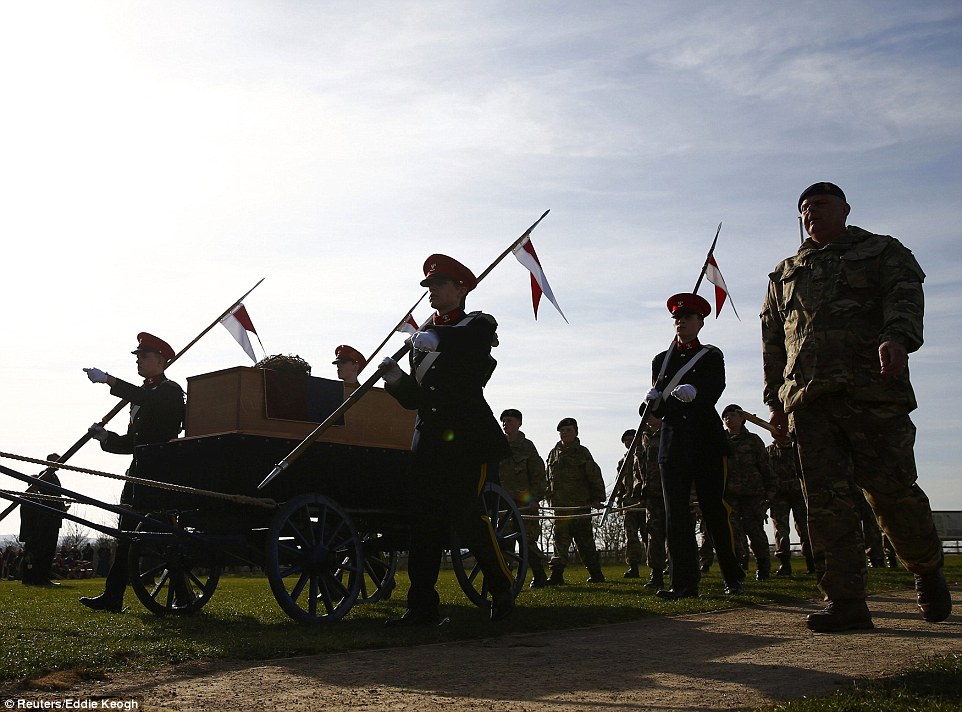











 Eric Hildrew .
Eric Hildrew . Tim Stanley ✔..........................Follow
Tim Stanley ✔..........................Follow Georgia
Georgia  Rachael Collins...................................Follow
Rachael Collins...................................Follow Alex Allan..........................................Follow
Alex Allan..........................................Follow Charlie Featherstone.......................Follow
Charlie Featherstone.......................Follow rosamundi ن
rosamundi ن Dave Robinson...................................................Follow
Dave Robinson...................................................Follow Richard Humphreys..............................Follow
Richard Humphreys..............................Follow





